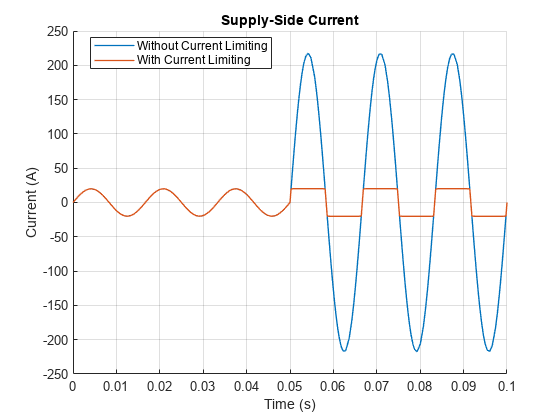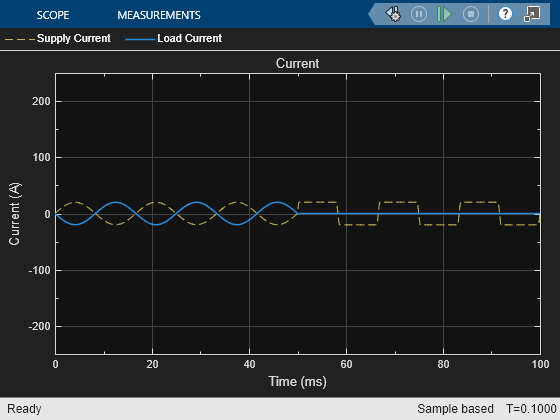Protect Components During Fault Using Current Limiter Block
This example shows how to use a Current Limiter block to protect a resistor from a short circuit or failure of the load.
Model Overview
Open the ee_fault_current_limiter model.
myModel = "ee_fault_current_limiter";
open_system(myModel)
When the simulation time is 50 ms, the Fault block triggers a fault. The SPDT Switch block enables or disables the Current Limiter block. You can control the SPDT Switch block by using the Constant block. The Threshold parameter of the SPDT Switch block is 0.5 V. You can switch the current limiter on by setting the Constant parameter of the Constant block above this threshold. You can switch the current limiter off by setting the Constant parameter of the Constant block to a value less than or equal to this threshold.
Simulate Model Without Limiting Current
To disable the Current Limiter block in the model, set the Constant parameter of the Constant block to 0 V and simulate the model.
set_param(myModel+"/Constant","constant","0"); sim(myModel);

result1 = simlog_ee_fault_current_limiter;
In the model, open the Scope block.
The plot of the supply current over time indicates that the load is in short circuit when the fault trigggers. This fault leads to a substantial increase in the current that the power supply requires because the resistance of the Supply-Side Resistor block is much lower than the resistance of the Load block.

Set Current Limiter Parameters
The Current Limiter block maintains the current on the supply side at values comparable to normal operation once the fault triggers. Set the Current Limit parameter of the Current Limiter block to 20 A. This value is close to the peak current on the supply side during normal operation. This setting prevents the current from substantially exceeding this value during a fault without limiting the current during normal operation.
set_param(myModel+"/Current Limiter","ilim","20");
Set the Voltage drop when current starts to limit parameter of the Current Limiter block to 0.1 V. When the current is under the limit, the Current Limiter block behaves like a resistor with an average resistance roughly equal to the voltage drop when the current starts to limit divided by the current limit. In this example, this resistance is 0.005 ohm. This value is much lower than the resistance of the Supply-Side Resistor, which is 1 ohm. This low value ensures that the Current Limiter block has negligible impact on the current during normal operation.
set_param(myModel+"/Current Limiter","vlim","0.1");
To enable the Current Limiter block in the model, set the Constant parameter of the Constant block to 1 V and then simulate the model.
set_param(myModel+"/Constant","constant","1"); sim(myModel);

result2 = simlog_ee_fault_current_limiter;
Plot and Compare Results
Plot the current on the supply side with and without current limiting.
During normal operation, the Current Limiter block has a negligible impact on the current. When the fault triggers, the Current Limiter block maintains the current at values comparable to normal operation and protects the resistor from damage.
ee_fault_current_limiter_plot_results(result1,result2)
